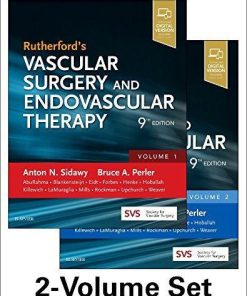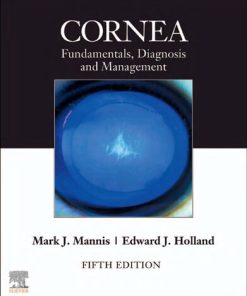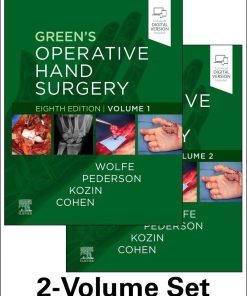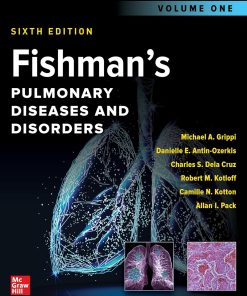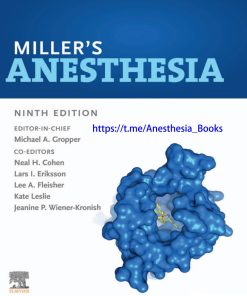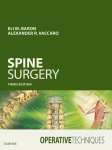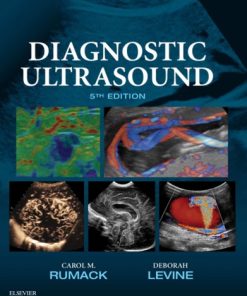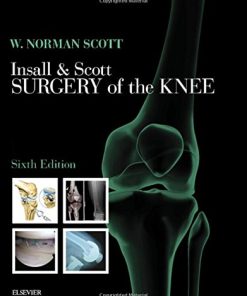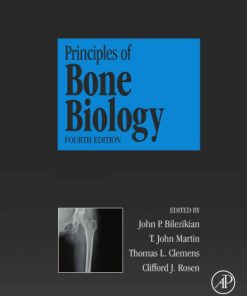Benzel’s Spine Surgery 2 Volume Set Techniques Complication Avoidance and Management 5th Edition by Michael Steinmetz 0323636691 9780323636698
$50.00 Original price was: $50.00.$25.00Current price is: $25.00.
Benzel’s Spine Surgery, 2-Volume Set: Techniques, Complication Avoidance and Management 5th Edition by Michael P Steinmetz Md – Ebook PDF Instant Download/DeliveryISBN: 0323636691, 9780323636698
Full download Benzel’s Spine Surgery, 2-Volume Set: Techniques, Complication Avoidance and Management 5th Edition after payment.
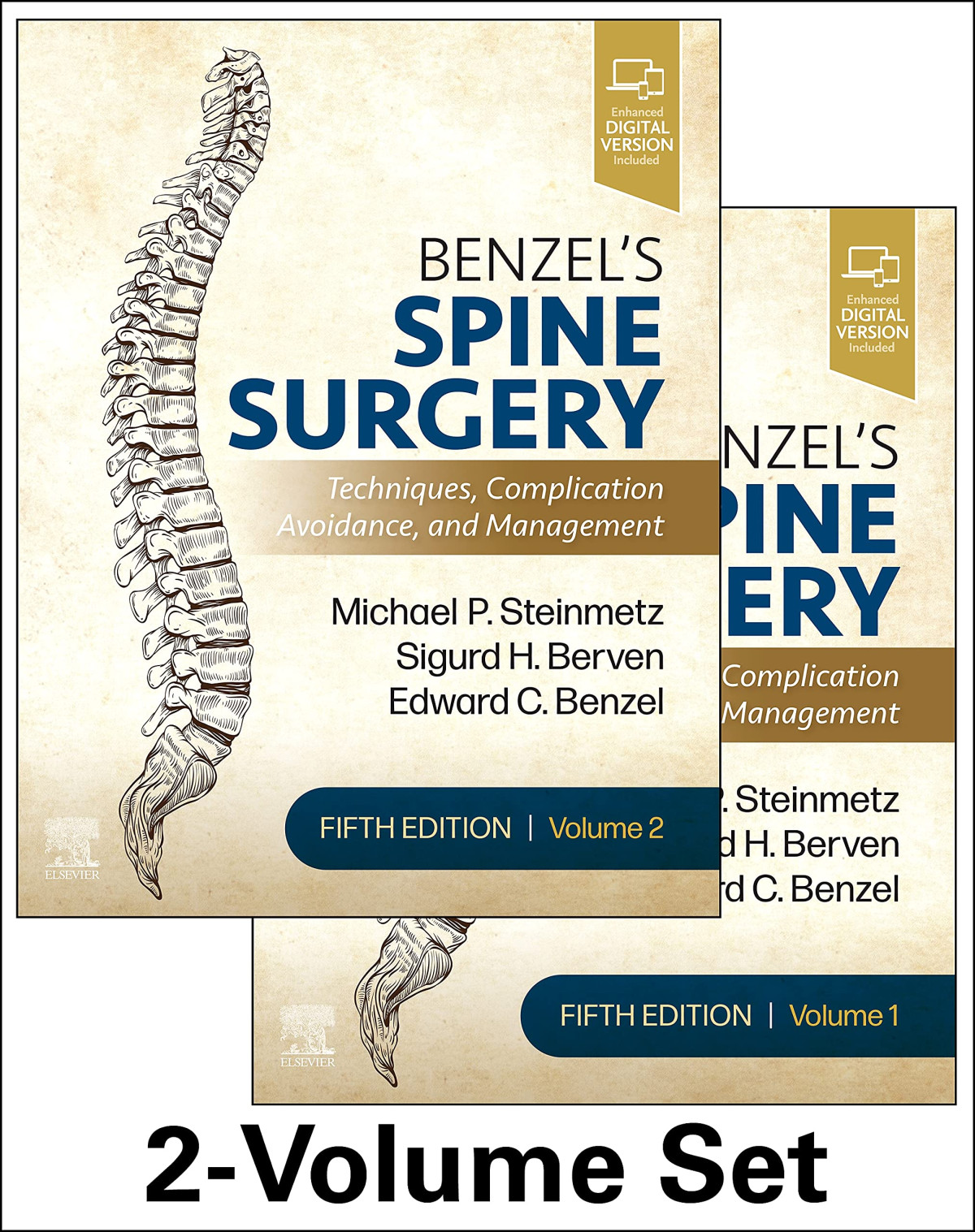
Product details:
ISBN-10 : 0323636691
ISBN-13 : 9780323636698
Author : Michael P Steinmetz Md
Written and edited by world-renowned experts in the field, Benzel’s Spine Surgery: Techniques, Complication Avoidance and Management, 5th Edition, provides expert, step-by-step guidance on the evaluation and management of disorders of the spine. This definitive, two-volume work explores the full spectrum of techniques used in spine surgery, giving you the tools you need to hone your skills and increase your knowledge in this challenging area. Clearly organized and extensively revised throughout, it features contributions from both neurosurgeons and orthopaedic surgeons to present a truly comprehensive approach to spine disease.
Benzel’s Spine Surgery, 2-Volume Set: Techniques, Complication Avoidance and Management 5th Table of contents:
Volume 1
Part 1. Fundamentals of the Spine
1. History of Spine Surgery
Antique Period and Spine Surgery
Medieval Period and Spine Surgery
Renaissance and Spine Surgery
Early Modern Period and Spine Surgery
Approaches to the Spine
Spinal Stabilization and Deformity Correction
Birth and Development of Spinal Fusion and Spinal Instrumentation
Paul Harrington and the Birth of Modern Surgical Stabilization
Ventral Approaches to the Spine
Laminoplasty
Minimally Invasive Spine Surgery, Robotics, and Navigation
Spine Imaging
Summary
2. History of Spine Biomechanics
Preclassical Antiquity
Classical Antiquity
Middle Ages (330–1453 ce)
The Renaissance and the Premodern Era
Emergence of Modern Biomechanics in the 20th Century
In vivo Human Biomechanical Studies
3. History of Spinal Instrumentation: The Modern Era
The Harrington Rod Area
The Birth of Segmental Spinal Fixation
The Comeback of Hook-Rod Systems and the Rod Rotation Revolution
Pedicle Screws
Development of Dynamic Stabilization Systems
Interspinous Devices
Ventral Thoracolumbar Instrumentation
Dorsal Cervical Instrumentation
Ventral Cervical Instrumentation
Development of Dynamic Systems for Anterior Cervical Instrumentation
Total Disc Arthroplasty: Cervical and Lumbar
Cage Technology: Horizontal and Vertical
Minimally Invasive Approaches Using Instrumentation
Image Guidance and Robotics
Summary
4. Functional Anatomy of the Spine
Spinal Curvature
Vertebra
Atlas (C1) and Axis (C2)
Subaxial Cervical Vertebrae (C3‒C7)
Thoracic Vertebrae
Lumbar Vertebrae
Sacrum and Coccyx
Intervertebral Discs
Spinal Ligaments
Spinal Musculature
Spinal Cord
5. Biomechanical Modeling of the Spine
Three-Dimensional Morphofunctional Anatomy and Biomechanics of the Asymptomatic and Scoliotic Spine
Biomechanics of Deformity Correction
Computational Biomechanical Modeling of the Spine
Applications of Biomechanical Models of the Spine
Verification, Validation, and Uncertainty Quantification
Conclusion
6. The Intervertebral Disc: Anatomy, Pathophysiology, and Aging
Anatomy
Vascular Supply
Innervation
Physiology
Disc Nutrition
Biomechanics
Aging
Extracellular Matrix Changes
Structural and Functional Changes
Summary
7. Muscles and the Spine: Dynamic Stabilization
General Concepts and Controversies
Anatomic Considerations
Microanatomy
Functional-Postural Considerations
Conclusion
8. Bone Physiology and Osteoporosis
Bone Structure and Function
Bone Density, Quality, and Strength
Pathological Conditions
Epidemiology of Osteoporosis
Assessment of Bone Status
Bone Health in Spine Patients
Conclusion
9. Applied Anatomy of the Thoracolumbar Spine
Spinal Alignment
Vertebrae and Ligaments
Neural Anatomy
Intradural Roots and the Cauda Equina
Vascular Anatomy
Anatomic Variation and Surgical Localization
10. Fundamentals of Spinal Alignment and Balance
Introduction and History
The Concept of the Spinal Organ and the Chain of Balance
The Importance of Pelvic Anatomy and its Parameters Upon Spine Alignment
Consequences
Practical Applications for Spinal Evaluation and Surgery
11. Applied Anatomy of the Spinal Cord
Functional Spinal Segment
Functional Anatomy of the Gray Matter
Functional Anatomy of the White Matter
Spinal Cord Control of Visceral Organs
Conclusion
12. Molecular and Anatomic Mechanisms of Nerve Root, Spinal Nerve, and Peripheral Nerve Injury
Cellular and Molecular Biology: Brief Review
Oligodendrocytes
Schwann Cells
Motor Exit Point Glia
Transition From Dura to Perineurium
Apoptosis
Necrosis
Anatomic Considerations and Mechanisms of Injury
Spinal Anatomy: Brief Review
Central Canal
Lateral Recess
Pedicles
Neural Foramen
Neural Structures
Dorsal Root Ganglion: Marking the Transition
Nerve Compression
Nerve Injury and Operative Implications
Iatrogenic Injury
Stretch Injuries
Double Crush Phenomenon
Familial Propensity to Compressive Neuropathy
Molecular Response to Injury and Putative Theraputic Options
Neuropathic Pain Considerations
Conclusion
13. Spine Fusion: Biology and Biomechanics
Anatomy of the Bone–Bone Interface
Biology of Bone Graft Incorporation
Temporal Profile of Graft Incorporation
Systemic Factors
Conclusion
14. Implant Attributes: Cantilever Beam Fixation
Cantilever
Cantilevers in Spinal Instrumentation
Bone–Screw Cantilever
Screw–Rod Interface
Clinical Modes of Failure and Strategies to Reduce Their Incidence
Bone–Screw Interface Failure
Screw–Rod Interface Failure
Conclusion
15. Biomechanics and Implant Materials: The Anterior Column
Historical Perspective
Interbody Fusion
Biomechanics
Cage Material and Design
Subsidence
Factors Affecting Construct Rigidity
Summary
16. Biomechanics of Motion Preservation Techniques
Biomechanics of the Functional Spinal Unit
Intervertebral Disc
Biomechanics of Intervertebral Disc Degeneration
Adjacent-Segment Degeneration
Biomechanics of Motion-Sparing Implants
Total Disc Arthroplasty
Other Motion-Sparing Devices
Conclusion
Disclaimer
17. Complications in Spine Surgery: Expected Rates and Classification
Patient Perception of Complications
Complication Risk Factors
Operative Complications
Postoperative Complications
Complication Classification
Conclusion
Pathophysiology of Spinal Disorders
Section 2.1. Pathophysiology of Congenital and Developmental Disorders
18. Spinal Cord Dysraphism and Myelodysplasia
Embryology
Spina Bifida Aperta––Open Neural Tube Defects
Myeloschisis
Myelomeningocele and Meningocele
Surgical Treatment
Fetal Myelomeningocele Repair
Outcomes
Spina Bifida Occulta––Closed Neural Tube Defects
Dermal Sinus Tract
Fatty Filum
Lipoma and Lipomyelomeningocele
Split Cord Malformation
Neurenteric Fistula or Cysts
Anterior Sacral Meningocele
Conclusion
19. Congenital Spinal Deformity
Pathogenesis and Spectrum of Congenital Spinal Deformity
Associated Anomalies, Evaluation, Imaging
Classification
Natural History and Observation
Surgical Indications, Imaging, Intraspinal Anomalies
Surgical Options, Timing of Intervention, Global Versus Local Treatment
Common Contemporary Surgical Options
Conclusion
20. Early-Onset Scoliosis
Classification
Initial Evaluation of the Child With Early-Onset Scoliosis
Consequences of Curve Progression: Pulmonary Development, Spinal Growth, and Thoracic Insufficiency Syndrome
Nonoperative Treatment of Early-Onset Scoliosis
Shilla
Complications
Conclusion
21. Late-Onset Idiopathic Scoliosis
Prevalence
Curve Patterns/Progression
Thoracic Curves
Lumbar Curves
Thoracolumbar Curves
Double-Major Curves
Skeletal Maturity/Progression
Summary
Cardiopulmonary Concerns
Restrictive/Obstructive Lung Disease
Mortality/Summary
Back Pain/Disability
Psychosocial Concerns
Summary
22. Scheuermann Disease
History
Nomenclature
Clinically Relevant Embryology of the Vertebral Column
Postnatal Development of the Vertebral Column
Sagittal Spinal Alignment and Deformity
Epidemiology
Etiopathogenesis
Pathophysiology
Pathology/Histopathology
Clinical Features
Radiographic Features
Magnetic Resonance Imaging Features
Natural History
Diagnosis
Differential Diagnosis
Treatment
Prognosis
Complications
Conclusion
23. Developmental Spondylolisthesis
Epidemiology
Pathophysiology
Hip–Spinopelvic Balance and Morphology
Postural Compensation Mechanisms in Developmental Spondylolisthesis
Spondylolisthesis Classification
Method for Classifying a Patient Using the Spinal Deformity Study Group Classification System
Implications for Surgical Treatment
Treatment Algorithm Using the Spinal Deformity Study Group Classification System
24. Craniovertebral Junction Deformities
Atlantoaxial Dislocation
Rotatory Atlantoaxial Dislocation
Vertical Atlantoaxial Dislocation
Lateral Atlantoaxial Dislocation
Goel Classification of Atlantoaxial Dislocation
Surgery for Atlantoaxial Dislocation
Basilar Invagination
Evolution of Personal Understanding
Reversibility of Musculoskeletal and Neural Alterations
Chiari Formation and Syringomyelia (Fig. 24.8)
Idiopathic Syringomyelia
Central Atlantoaxial Dislocation in Association With Cervical Myelopathy Related to Multisegmental Cervical Spondylosis, Ossification of the Posterior Longitudinal Ligament, and Hirayama Disease
25. Developmental Deformity in the Cervical Spine
Basilar Impression/Invagination
Occipitocervical Synostosis
Congenital Atlas Anomalies
Odontoid Anomalies
Posterior Arch Defects
Congenital Muscular Torticollis
Klippel–Feil Syndrome
Laxity of the Transverse Atlantal Ligament
Other Disorders With Common Cervical Spine Involvement
26. Tarlov Cysts
Epidemiology
Histopathology
Clinical Findings
Radiological Features
Pathogenesis
Differential Diagnosis
Diagnostic Cyst Aspiration
Summary
27. Dural and Meningeal Pathologies
Superficial Siderosis
Presentation
Imaging
Treatment and Outcome
Spinal Cord Herniation
Presentation
Imaging
Treatment and Outcome
Cerebrospinal Fluid Leaks and Spontaneous Intracranial Hypotension
Presentation
Imaging
Treatment and Outcomes
Segmental Amyotrophy Secondary to Dural Defect–Related Extraarachnoid Fluid Collections
Presentation
Imaging
Treatment and Outcomes
28. Chiari Malformations and Syringomyelia
History
Signs, Symptoms, and Imaging: Pathological Features
Pathophysiology
Patient Selection and Surgical Management
Postoperative Care and Complications
Prognosis
Summary
Section 2.2. Pathophysiology of Degenerative Disorders
29. Pathophysiology of Cervical Spondylosis, Radiculopathy, and Myelopathy
Cervical Spondylosis
Pathology
Cervical Spondylosis and Axial Neck Pain
Cervical Radiculopathy
Pathophysiology
Biomechanics
Histopathology
Spinal Cord Ischemia and Cervical Spondylotic Myelopathy
Summary
30. Pathophysiology of Thoracic Spondylosis, Radiculopathy, and Myelopathy
Anatomic Consideration of the Thoracic Spine
Specific Pathologies
Management of Thoracic Spine Pathologies
31. Pathophysiology of Intervertebral Disc Degeneration and Pain
Anatomy
Extracellular Matrix
Cells
Nutrition
Innervation
Function
The Degenerative Cascade
Physiological Degeneration
Pathological Degeneration
Degeneration Risk Factors
Diagnostics
Current and Future Diagnostic Methods With Magnetic Resonance Imaging
Summary and Obstacles to Improved Understanding and Clinical Translation
32. Deformity in the Cervical Spine
Background
Pathophysiology
Congenital Cervical Scoliosis
Idiopathic Scoliosis
Traumatic/Iatrogenic Scoliosis
Preoperative Evaluation
Surgical Outcomes
Conclusion
33. Adult Degenerative Scoliosis
Clinical Evaluation of the Adult Patient with Spinal Deformity
Diagnostic Imaging
Classification
Management of Adult Degenerative Scoliosis
Conclusion
34. Lumbar Spondylolisthesis
Definitions
Natural History
Management
Transforaminal Lumbar Interbody Fusion
Anterior Lumbar Interbody Fusion
Lateral Lumbar Interbody Fusion
Oblique Lumbar Interbody Fusion
Surgery for Spondylolisthesis in the Elderly
Management of Osteoporosis
Surgical Considerations for Patients With Osteoporosis
Cost Effectiveness
Guidelines
Surgical Treatment
Conclusion
Section 2.3. Pathophysiology of Traumatic Disorders
35. Occipitocervical Injuries
General Principles
Diagnosis and Management
C0––Occipital Condyle Fractures
C0–C1––Atlantooccipital Dislocations
C1 Fracture
Transverse Ligament Injuries
Rotatory C1–C2 Subluxations
C2 Fractures
Combination Occipitocervical Junction Injuries
Surgical Procedures
Dorsal C1–C2 and C1–C3 Fixation
Odontoid Screw Fixation
Ventral C1–C2 Fixation
Ventral C2–C3 Fixation
Dorsal Occipital Cervical Fusion
Summary
36. Subaxial Cervical Spine Injuries
Anatomy
Clinical Assessment
Radiographic Assessment
Injury Classification
Management
Treatment by Fracture Type
Prognosis
Conclusion
37. Thoracic and Lumbar Spine Injuries
Evaluation and Diagnosis
Assessment in the Emergency Department
Imaging
Classification of Thoracolumbar Fractures
Thoracolumbar Injury Classification and Severity Score
Management of Thoracolumbar Fractures
Management of Specific Thoracolumbar Injuries
Conclusion
38. Peripheral Nerve Injury
Anatomy and Physiology of the Peripheral Nervous System
Biology of Nerve Injury and Repair
The Nerve Cell Body and Proinflammatory Response in the Nerve Injury Zone
Central Nervous System Versus Peripheral Nervous System Regeneration
Current and Future Surgical Nerve Repair Concepts
Innovative Current and Future Directions
Cauda Equina Syndrome
Clinical Syndrome
39. Spinal Cord Injury
Epidemiology of Spinal Cord Injury
Mechanisms of Spinal Cord Injury
Pathophysiology
Clinical Manifestations of Spinal Cord Injury
Patterns of Incomplete Spinal Cord Injury
Special Considerations
Conclusion
40. Spinal Injuries in Sports
Epidemiology of Sports-Related Spinal Injuries
Cervical Spine and Brachial Plexus
Thoracic Spine
Lumbosacral Spine
Summary
Section 2.4. Pathophysiology of Inflammatory and Infectious Disorders
41. Rheumatoid Arthritis
Pathophysiology
Clinical Manifestations
Radiological Evaluation
Operative Indications
Specific Regions of the Spine
Summary
42. Ankylosing Spondylitis and Related Disorders
Introduction and Epidemiology
Pathophysiology
Clinical Manifestations and Diagnosis
Laboratory Findings
Radiographic Findings
Nonoperative Treatment Modalities
Operative Interventions: Fractures
Deformity
Preoperative Planning
Osteotomy: Cervical
Osteotomy: Thoracolumbar
Cervical Pedicle Subtraction Osteotomy: C7 Osteotomy Technique
Complications
Conclusion
43. Ossification of the Posterior Longitudinal Ligament
Demographics
Natural History
Genetic Expression and Biomarkers
Symptoms and Diagnosis
Imaging Evaluation and Classification
Conclusion
44. Primary Infections of the Spine
Pyogenic Infections: Spondylodiscitis, Vertebral Osteomyelitis, and Epidural Abscess
Other Granulomatous Spinal Lesions
Brucellosis
Fungal Infections
Conclusion
45. Secondary Infections of the Spine
Risk Factors
Prevention
Clinical Presentation
Diagnostic Workup
Management
Conclusion
46. Primary Tumors of the Spine
Symptoms
Radiological Evaluation
Management
Treatment
Primary Lesions
Conclusion
47. Metastatic Tumors of the Spine
Presentation
Imaging Findings
Evaluation
Neurological Function
Oncological Status
Mechanical Instability
Systemic Considerations
Management
Surgical Approaches
Minimally Invasive Surgery
Vertebroplasty and Kyphoplasty
Conclusion
48. Intradural Extramedullary Spine Tumors
Epidemiology
Patient Presentation
Nerve Sheath Tumors
Surgical Considerations
Conclusion
49. Intramedullary Spinal Cord Lesions
Patient Evaluation
Patient Selection
Surgical Objectives
Surgical Technique
Advances in Surgical Approaches
Postoperative Management
A Note on Differential Diagnosis
Summary
50. Brachial Plexus Tumors Extending Into the Cervicothoracic Spine
Clinical Presentation and Imaging Findings
Surgical Approaches
Surgical Considerations for Brachial Plexus Tumors Extending Into the Cervical and Upper Thoracic Spine
Dorsal Approach
Ventral Supraclavicular Approach
Dorsal Subscapular Approach
Conclusion
Section 2.6. Pathophysiology of Syndromic Disorders Affecting the Spine: Connective Tissue and Vascular
51. Spinal Disorders Associated With Connective Tissue Disorders
General Considerations
Atlantoaxial Instability
Basilar Invagination
Cervical Failure of Segmentation
Congenital Scoliosis
Dystrophic Scoliosis
Kyphosis
Dural Ectasia
Thoracic Dystrophy
Spinal Deformity From Soft Tissue Contractures
Spinal Stenosis
Spondylolisthesis
Spinal Angiomas
Summary
52. Osteoporosis, Osteomalacia, and Metabolic Bone Disease
Osteoporosis
Osteomalacia
Paget Disease of the Bone
53. Vascular Malformations of the Spine
History and Nomenclature
Embryology and Vascular Anatomy
Imaging Techniques
Extradural Arteriovenous Fistulas
Type 1 Dural Arteriovenous Fistulas
Type II Glomus Arteriovenous Malformations
Type III Juvenile Extradural-Intradural Arteriovenous Malformations
Type IV Intradural Perimedullary Arteriovenous Fistula
Conus Arteriovenous Malformations
Spinal Aneurysms
Cavernous Angiomas
54. Neuromuscular Disorders in the Pediatric Spine
Classification of Neuromuscular Scoliosis
General Considerations for Patients With Neuromuscular Scoliosis
Neuromuscular Scoliosis Secondary to Cerebral Palsy
Specific Preoperative Considerations for Patients With Cerebral Palsy
Outcomes of Corrective Scoliosis Surgery in Patients With Cerebral Palsy
Neuromuscular Scoliosis Secondary to Myelodysplasia
Specific Preoperative Considerations in Patients With Scoliosis Because of Myelomeningocele
Intraoperative Considerations for Patients With Myelomeningocele
Outcomes in Patients With Scoliosis Secondary to Myelomeningocele
Neuromuscular Deformity in the Adult
Management of Neuromuscular Deformity in the Adult
Summary
55. Neuromuscular Disorders in the Adult Spine
Pathophysiology
Classification and Evaluation
Parkinson Disease
Immunomodulatory Disorders (Multiple Sclerosis)
Conclusion
Section 2.7. Pathophysiology of Postoperative Spinal Disorders
56. Postoperative Spinal Disorders—Cervical
Background
Anterior Cervical Spine Surgery
Pseudoarthrosis After Anterior Cervical Spine Surgery
Adjacent Segment Disease After Anterior Cervical Spine Surgery
Posterior Cervical Spine Surgery
Early Postoperative Complications in Posterior Cervical Spine Surgery
Postlaminectomy Kyphosis in Posterior Cervical Spine Surgery
Pseudoarthrosis in Posterior Cervical Spine Surgery
Fusion Choices in Posterior Cervical Spine Surgery
Avoiding Iatrogenic Destabilization
Conclusion
57. Postoperative Spinal Deformity
Pathophysiology: Prevalence and Impact
Cervical Spine Alignment
Lumbar Degenerative Alignment
Thoracolumbar Deformity Alignment
Avoiding Fusion of the Spine in Malalignment
Treatment of Postoperative Malalignment of the Spine
Conclusion
58. Adjacent Segment Degeneration and Disease of the Cervical Spine
Terminology
Biomechanics of Adjacent Segment Pathology
Adjacent Segment Degeneration (Radiographic Adjacent Segment Pathology)
Adjacent Segment Disease (Clinical Adjacent Segment Pathology)
Prevention of Adjacent Segment Pathology
Minimize Disruption of Surrounding Soft Tissue
Patient/Level Selection
Sagittal Alignment
Authors’ Perspective
59. Adjacent Segment Degeneration and Disease of the Lumbar Spine
Pathophysiology
Epidemiology
Risk Factors
Surgical Strategies to Avoid Adjacent Segment Disease
Surgical Strategies to Manage Adjacent Segment Disease
Outcomes and Complications
Conclusion
60. Proximal and Distal Junctional Kyphosis and Failure
Prevalence and Predictive Factors
Adolescent Idiopathic Scoliosis
Adult Spinal Deformity
Scheuermann Kyphosis
Impact of Proximal Junctional Kyphosis and Distal Junctional Kyphosis
Strategies for Prevention
Conclusion
Part 3. Evaluation of Patients with Spinal Disorders
61. Physical and Neurological Examination
Taking a Medical History
General Physical Examination
Spine Examination
Neurological Examination
Sensory Examination
Differentiating Spinal Cord and Peripheral Nerve Pathology From Bony or Soft Tissue Pathology
Video-Telemedicine Spine Evaluation During the COVID-19 Pandemic
62. Sagittal Spinal Alignment: An Evolutionary Perspective
The Anthropological Development of the Normal Human Upright Sagittal Balance
The Anatomical Transition From Quadrupeds to Bipeds
The Establishment of Spinal Parameters
Radiographic Measurement of Global Spinal Alignment
Clinical Relevance of the Spinopelvic Relationship
The Contribution of Pelvic Anatomy to Global Alignment
The Relevance of Sagittal Balance to Spinal Surgery Planning
Conclusion
63. Spinal Alignment: Significance and Preoperative Planning
Clinical and Radiographic Evaluation
Etiology of Sagittal Malalignment
Exhaustion of Nonsurgical Management
Surgical Management
Conclusion
64. Overview of Imaging Procedures Available for Spinal Diagnosis
Plain Radiography
Myelography
Fluoroscopy
Nuclear Scans
Computed Tomography
Ultrasonography
Discography
Magnetic Resonance Imaging
Diffusion Tensor Imaging
Conclusion
65. Electrodiagnostic Studies
Key Anatomy for Electrodiagnosis
Nerve Fiber Injury Types and Relevance
Components of the Electrodiagnostic Examination
Electrodiagnostic Localization of Spinal Disorders
Case Studies
Polyradiculopathy
Cervical Root Avulsion
Lumbar Canal Stenosis
Postoperative Electrodiagnostic Examination
Recommendations for the Referring Physician
66. Differential Diagnosis of Surgical Disorders of the Spine
Degenerative Disease of the Cervical Spine
Degenerative Disease of the Lumbar Spine
Trauma
Posttraumatic Syringomyelia
Charcot Spine
Spinal Infection
Spondylodiscitis
Spinal Epidural Abscess
Neoplastic Disease
Inflammatory Disease of the Spine
Rheumatoid Arthritis
Ankylosing Spondylitis
Vascular Lesions Affecting the Spinal Cord
Neurological Conditions of the Spinal Cord and Spinal Nerves
Multiple Sclerosis
Amyotrophic Lateral Sclerosis
Guillain–Barré Syndrome
Masqueraders of Spinal Pathology
Musculoskeletal System
Nervous System
Visceral Organs and Related Systems
Summary
67. Patient Selection for Spine Surgery: Preoperative Optimization
Background
Diabetes Mellitus
Tobacco Abuse
Obesity
Anemia
Osteoporosis
Psychosocial Factors
Conclusion
68. Evaluation of the Aging Patient
Structural Changes in the Spine
Osteoporosis
Functional Assessment
Age-Related Risk Factors
Summary
69. Preoperative Evaluation of Psychosocial Aspects and Work-Related Issues
Psychosocial Aspects
Work-Related Issues
Conclusion
70. Preoperative Evaluation of Patients With Tumors Affecting the Spine
Classification of Spinal Tumors
Diagnostic Imaging
Plain Radiographs
Bone Scan
Computed Tomography
Magnetic Resonance Imaging
Angiography
Laboratory Tests and Inflammatory Markers
Consideration of Spine Surgery in Metastatic Cancer
The NOMS Criteria
Neurological
Oncological
Mechanical Instability
Systemic
Prognostic Scoring Systems
Conclusion
71. Measuring Preoperative Health-Related Quality of Life: What Metrics Matter
The Importance of Health-Related Quality of Life in Spine Care
Key Characteristics of Health-Related Quality of Life Tools
Reliability, Validity, and Responsiveness
Some Commonly Used Health-Related Quality of Life Tools in Spine Care (Table 71.1)
Choice of Health-Related Quality of Life Tools: Potential Considerations
Conclusion
Management of Spinal Disorders
Section 4.1. Nonoperative Approaches
72. Rehabilitation and Interventions in Management of Spinal Disorders
Etiology of Back and Neck Pain
Medical Treatment Options
Nonpharmacological Treatments
Transcutaneous Electrical Nerve Stimulation, Ultrasound, Taping
Summary: An Evidence-Informed Approach to Nonsurgical Management of Back and Neck Pain
73. Spine Injections
Introduction
Epidural Injection
Anatomy
Cervical Epidural Steroid Injections
Thoracic Epidural Steroid Injections
Lumbar Epidural Steroid Injections
Caudal Epidural Steroid Injection
Medications
Complications
Contraindications
Interlaminar Versus Transforaminal Approach
Transforaminal Epidural Steroid Injections and Selective Nerve Root Blocks
Indications
Anatomy
Technique
Cervical Technique
Lumbar Technique
Sacral Technique
Thoracic Technique
Complications
Facet Joint Injections, Medial Branch Nerve Blocks, and Radiofrequency Denervation
Introduction
Anatomy
Facet Injections
Thoracic Intraarticular Facet Injection
Thoracic Medial Branch Block and Radiofrequency Treatment
Lumbar Intraarticular Facet Injection
Lumbar Medial Branch Block and Radiofrequency Treatment
Complications
Sympathetic Blocks
Indications for Stellate Ganglion Blocks
Anatomy of the Stellate Ganglion
Technique of the Stellate Ganglion Block
Complications of Stellate Ganglion Block
Indications for Lumbar Sympathetic Block
Anatomy of the Lumbar Sympathetic Chain
Technique of the Lumbar Sympathetic Block
Complications of the Lumbar Sympathetic Block
Diagnostic Block Considerations
Conclusion
74. Cognitive Behavioral Therapy and Back Pain
Chronic Pain: The Essential Role of Psychology
Key Components and Goals of Treatment for Chronic Pain and Chronic Low Back Pain
Theoretical Foundation for Cognitive Behavioral Therapy for Pain
Cognitive Behavioral Therapy: In-Depth Application to Chronic Pain
Empirical Support for Cognitive Behavioral Therapy for Chronic Low Back Pain
Cognitive Behavioral Therapy is Effective for Patients with Chronic Low Back Pain
Conclusion
75. Regenerative Strategies and Intervertebral Disc Degeneration
Background
Anatomy and Pathophysiology of the Intervertebral Disc
Biological Therapy
Cell-Based Therapy
Indications for Disc Degeneration and Discogenic Pain
Conclusion
76. Neuromodulation and Rehabilitative Interventions for the Spine
Past: Spinal Stimulation for Pain Control
Present: Advances in Neuromodulation
New Targets for Neuromodulation: Multifidus Stimulation
Spinal Epidural Stimulation for Chronic Paralysis
Future: The Spine as a Platform for Clinical Neuromodulation
Treatment of Spasticity Related to Cerebral Palsy
Advanced Spinal Imaging
Spine Machine Interfaces
Conclusion
77. Pain Management: Opioids and Alternatives
Acetaminophen
Nonsteroidal Antiinflammatory Drugs
Oral Steroids
Antidepressants
Opioids
Muscle Relaxants
Anticonvulsants
Topicals
Cannabinoids
Conclusion
Section 4.2. Operative Management of Spinal Disorders: Overview and Principles
78. Fundamentals of Spine Surgery
The Decision-Making Process
Patient Selection
Consent for Surgery
Surgical Considerations
Technology and the Spine
Economics
Conclusion
79. Perioperative Management Protocols: Enhanced Recovery After Surgery
Introduction
Brief History of Enhanced Recovery After Surgery in Other Surgical Specialties
Physiological Foundation for Enhanced Recovery After Surgery
Need for Enhanced Recovery After Surgery Programs in Spinal Surgery
Phases of Enhanced Recovery After Surgery in Spinal Surgery
University of Miami Spinal Enhanced Recovery After Surgery Experience
Literature Review of Established Spinal Enhanced Recovery After Surgery Programs
Conclusion and Future Direction
80. Surgical Incisions, Positioning, and Retraction
Patient Positioning
Retractors
Approaches
81. Intraoperative Imaging Protocols
General Considerations
Plain Film Radiography
Fluoroscopy
Image-Guided Navigation
Robot-Assisted Spinal Instrumentation
Case Illustration
Conclusion
82. Anesthesia for Spine Surgery and the Prevention of Complications
Preoperative Assessment
Pathophysiological Changes With Prone Position
Important Functions of the Glycocalyx
Suitable and Practical Techniques for Goal-Directed Fluid Therapy and Perfusion Pressure During Spine Surgery
Commonly Used Colloids During Spine Surgeries
In Conclusion
Changes in Respiratory Physiology
Poisson Effect and Prone Position
Intraoperative Neurophysiological Monitoring
Mechanisms and Pathophysiology of Spinal Monitoring Changes
Somatosensory-Evoked Potentials
Motor-Evoked Potentials
Treatment of Surgical Pain After Spine Surgeries
83. Intraoperative Monitoring in Routine and Complex Surgery
Somatosensory-Evoked Potentials
Electrode Placement
System Settings
Intraoperative Somatosensory-Evoked Potential Monitoring Assessment
Motor-Evoked Potentials
Electrode Placement
Intraoperative Motor-Evoked Potential Monitoring Assessment
Electromyography
Free-Running Electromyography
Triggered Electromyography
Anesthesia
Significant Changes in Neuromonitoring
Conclusion
84. Blood Management and Complex Spine Surgery
Brief Review of Surgical Hemostasis
Preoperative Evaluation
Transfusion Risks and Counseling
Anesthetic Techniques for Lessening Intraoperative Blood Loss
Operative Team Management
Surgical Techniques for Reducing Blood Loss
Local Agents for the Reduction of Blood Loss
Positioning
Intraoperative Blood Transfusion
Intraoperative and Postoperative Blood Salvage
Postoperative Drugs and Blood Loss
Treatment and Diagnosis of Diffuse Intraoperative and Postoperative Bleeding
Summary
85. Intraoperative Crisis Management in Spine Surgery: What to Do When Things Go Bad
Anesthetic Crises
Electrophysiological Spinal Cord Monitoring
Neurological Injuries
Conclusion
Volume 2
86. Biologics in Spine Fusion Surgery
Autograft
Iliac Crest Bone Graft
Local Bone Graft
Bone Marrow Concentrates
Allograft
Demineralized Bone Matrix
Cellular-Based Allograft
Synthetic (Ceramic-Based) Bone Substitutes
Recombinant Human Bone Morphogenetic Protein–2
Conclusion
87. Osteointegration: The Bone and Implant Interface
Biological Process
Materials
Surface Topography
Surface Chemistry
Hydroxyapatite Coating
Porosity
Conclusion
88. Common Complications in Spine Surgery: Pseudoarthrosis
Biology of Bone Healing
Diagnosis of Pseudoarthrosis
Risk Factors for Pseudoarthrosis
Incidence and Treatment
Augmentation of Fusion With Graft, Biologics, and Other Factors
Summary
89. Postoperative Medical Complications
Enhanced Recovery After Surgery Pathways
Pulmonary and Thromboembolic Complications
Cardiac Complications
Renal Complications
Gastrointestinal Complications
Miscellaneous Complications
Conclusion
90. Preventing Postoperative Infections: An Evidence-Based Approach
Preoperative Factors
Intraoperative Factors
Postoperative Factors
Summary of the 2017 Centers for Disease Control Guidelines
Summary
91. Neurological Complications of Common Spine Operations
Occipitocervical Junction
Anterior Cervical
Posterior Cervical
Thoracic Spine
Lumbar Spine
Posterior Lumbar
Anterior and Lateral Lumbar
Conclusion
92. Cerebrospinal Fluid Leak: Repair and Outcomes
Incidence
Pathophysiology
Clinical Features
Diagnostic Studies
Conservative Management
Surgical Management
Conclusion
93. Arachnoiditis
Anatomy
Pathogenesis
Etiology
Clinical Features
Radiographic Features
Spinal Epidural Fibrosis
Treatment
Summary
94. Arachnoiditis and Syringomyelia
Epidemiology and Definition
Pathophysiology of Arachnoiditis-Associated Syringomyelia
Radiographic Findings of Arachnoiditis
Clinical Presentation and Clinical Course
Treatment and Outcomes
Arachnoiditis Ossificans
Summary
95. Posttraumatic and Idiopathic Syringomyelia
Epidemiology
Classification
Etiology
Clinical Presentation
Diagnosis
Management
Conclusions
96. Vascular and Soft Tissue Complications
Complications at the Craniovertebral Junction
Complications in the Subaxial Spine
Recurrent Laryngeal Nerve Injury
Esophageal Injury
Esophageal Repair
Laryngotracheal Injuries
Carotid and Vertebral Artery Injury
Complications at the Cervicothoracic Junction and in the Thoracic Spine
Thoracic Duct Injuries
Vascular Injuries
Pulmonary Complications
Thoracolumbar Junction and Lumbar Spine
Splenic and Vascular Injury
Ureteral Injury
Bowel Injury
Transabdominal Approaches to the Lumbosacral Spine
Lymphocele After the Anterior Approach to the Spine
Complications of Posterior Lumbar Discectomy
Complications of Minimally Invasive Thoracolumbar Discectomy and Fusion
Complications Related to Thoracoscopy and Transthoracic Discectomy
Vascular Injury
Other Visceral Injury
Instrumentation Complications
Complications of Vertebral Cement Augmentation
Summary
97. Postoperative Spinal Deformities
Introduction
Decompression-Related Postoperative Spinal Deformities
Instrumentation-Related Postoperative Deformities
Adjacent Segment Disease
Proximal Junctional Failures
Surgical Correction of Postsurgical Deformity
Conclusion
98. Implant Wear, Degradation, and Breakage
Implant Wear
Wear Debris
Particulate Characterization
Ionic Concentrations
Corrosion
Conclusion
99. Spine Readmissions and Reoperations
Readmission
Cervical Spine
Thoracolumbar Spine
Conclusion
Section 4.3. Operative Management of Spinal Disoders: Occipital and Cervical
100. Cervical Spine Construct Design
Fundamental Concepts
Indications for Cervical Construct Application
Construct Selection
Ventral Constructs
Dorsal Constructs
Economic Considerations
Supplementary External Immobilization
101. Occipitocervical Spine Approaches for Decompression
Occipitocervical Spine
Pathology
Surgical Anatomy
Vertebral Artery
Atlantooccipital Joint
Approaches to the Occipitocervical Region
Extended Approaches to the Craniocervical Junction
Summary
102. Occipitocervical Spine Posterior Approaches for Fusion
General Considerations
Anesthetic Considerations
Ventral Approaches
Dorsal Approaches
Transarticular Screw Fixation
C1‒C2 Screw/Rod Constructs
Occipitocervical Fusion
Patient-Reported Outcomes
Summary
103. Endoscopic and Transnasal Approaches to the Craniocervical Junction
Preoperative Evaluation
Endoscopic Transnasal Surgical Technique
Endoscopic Transnasal Transclival Approach
Endoscopic Transnasal Odontoidectomy Approach
Reconstruction
Postoperative Care
Discussion
Clinical Outcomes: Advantages and Limitations
Conclusion
104. Cervical Spine and Cervicothoracic Junction—Posterior
Anatomy
Posterior Triangle of the Neck
Spinal Anatomy
Discs
Ligaments
Ligamentum Nuchea
Intravertebral Foramen
Blood Supply
Posterior Subaxial Cervical Spine and Cervicothoracic Junction Pathology
Subaxial Cervical Spine and Cervicothoracic Junction Trauma
Other Pathologies of the Subaxial Cervical Spine and the Cervicothoracic Junction
Posterior Surgical Approaches
Posterior Keyhole Laminotomy/Foraminotomy
Transpedicular
Costotransversectomy and the Lateral Extracavitary Approach
Minimally Invasive Posterior Approach
105. Posterior Cervical Decompressions: Cervical Laminectomy and Laminoforaminotomy
Technique
Anesthetic Concerns
Incision and Dissection
Laminectomy
Foraminotomy
Summary
Acknowledgment
106. Cervical Laminoplasty
Background of the Development of Laminoplasty
Surgical Indication
Surgical Technique used for Laminoplasty
Surgical Results
Complications
Closure of Expanded Lamina
Segmental Motor Paralysis (C5 Palsy)
Axial Pain
Conclusions
107. Dorsal Subaxial Cervical Instrumentation Techniques
Etiologies
Indications for Surgery
Trauma
Tumor
Degenerative Disorders
Surgical Exposure
Bony Fusion
Techniques
Lateral Mass Screw Fixation
Cervical Pedicle Screw Fixation
Minimally Invasive Intrafacet Fusion
Decision to Cross the C7–T1 junction
Postoperative Care
Complication Management
Neurological and Vascular Complications
Spinal Complications
Wound Complications
Summary
108. Posterior Percutaneous and Minimally Invasive Approaches to Decompression and Arthrodesis of the Cervical Spine
Posterior Minimally Invasive Approaches for the Cervical Spine
Indications
Preoperative Evaluation
Operative Setup
Positioning
Surgical Approach
Laminotomy/Foraminotomy/Discectomy
Decompression for Stenosis
Posterior Cervical Transfacet Fusion Cages
Lateral Mass Fixation
Closure and Postoperative Care
Outcomes and Results
Complications
Summary
109. Cervical Spine and Cervicothoracic Junction—Anterior Approach
Cervical Spine Pathology and Indications for Surgery
Surgical Approaches
110. Anterior Cervical Discectomy and Corpectomy
Anterior Cervical Pathologies
Approach and Limitations
Retractor and Distracting Pin Placement
Conclusion
111. Management of Soft Cervical Disc Herniation: Controversies and Complication Avoidance
Approach to Surgical Decision Making
Surgical Options for Soft Disc Herniation
Conclusion
112. Anterior Subaxial Cervical Fixation and Fusion Techniques
Background
Anterior Instrumentation
Interbody Options for Anterior Subaxial Fixation
Anterior Interbody Pseudarthrosis and Subsidence
Additional Techniques for Anterior Subaxial Fixation and Fusion
Anterior Controllable Antedisplacement Fusion
Conclusion
113. Cervical Total Disc Arthroplasty
Rationale for Cervical Arthroplasty
Nomenclature, Biomaterials, and Biomechanics
Indications and Contraindications
Cervical Arthroplasty: The Clinical Evidence
Effect of Cervical Disc Replacement on Adjacent Segment Disease
Potential Complications and Complication Avoidance
Conclusion
Disclosure
114. Combined Ventral-Dorsal Surgery
Acute Cervical Spine Injury
Kyphotic Deformity
Neoplasms
Ankylosing Spondylitis
Cervical Spondylotic Myelopathy
Complications and Avoidance
Summary
Section 4.4. Operative Management of Spinal Disorders: Thoracolumbar
115. Thoracic and Lumbar Spine Construct Design
Nomenclature
Indications for Spinal Instrumentation
Construct Types (Modes of Force Application)
Development of a Construct Blueprint
Construct Design Strategies
116. Posterior Approaches to the Thoracic Spine
Anatomy
Approaches
Midline Approach
Transpedicular Approach
Costotransversectomy
Lateral Extracavitary Approach
Summary
117. Anterior and Lateral Approaches to the Thoracic Spine
Transpedicular Approach
Costotransversectomy and Lateral Extracavitary
Mini-Open Extracavitary Transpedicular Corpectomy
Retropleural Thoracotomy
Minimally Invasive Retropleural Approach
Transpleural Thoracotomy
Endoscopic Transpleural Thoracotomy
Direct Anterior Thoracic Approaches
Summary
118. Minimally Invasive Lateral Thoracic Decompression
Indications for Operative Intervention
Minimally Invasive Surgical Approaches for Thoracic Decompression
Conclusion
119. Thoracoscopic Corpectomy and Reconstruction
Advantages and Disadvantages
Indications and Contraindications
Preoperative Assessment and Planning
Operative Technique
Conclusion
120. Posterolateral Thoracolumbar Fusion
Surgical Technique
Instrumentation
Spondylolisthesis as an Indication for Posterolateral Fusion
Cost Effectiveness
Summary
121. Posterior Thoracic and Lumbar Universal Spine Instrumentation
History
Surgical Indications
Distraction
Tension Band Fixation
Summary
122. Midline Lumbar Interbody Fusion With Cortical Bone Trajectory Pedicle Screw Placement
Surgical Indications and Contraindications
Surgical Technique
Postoperative Care
Complications
123. Transforaminal Lumbar Interbody Fusion
Indications
Preoperative Radiographic Studies
Overview of the Procedure
Surgical Technique
Phase I: Access Port Docking, Exposure, and Pedicle Screw Placement
Phase II: Osteotomies and Decompression of the Segment
Phase III: End Plate Preparation, Trial, and Interbody Placement
Complication Avoidance
Surgical
Early Postoperative Phase
Late Postoperative Phase
Conclusion
124. Dorsal Semirigid Stabilization
Adjacent Segment Pathology
Semirigid System Rationale
Neutral Semirigid Systems
Compressive Semirigid Systems
Distractive Semirigid Systems, Interspinous Process Spacers
Total Facet Replacement Systems
ACADIA
TOPSTM Posterior Arthroplasty System
Disadvantages and Complications
Conclusion
125. Lumbar Total Disc Arthroplasty
Background
Indications
Current Designs
Lumbar Tdr Devices Available in The United States
Lumbar Tdr Devices Available Outside the United States
Two-Level Lumbar Tdr
Mid- and Long-Term Outcomes
Hybrid Reconstruction
Adjacent Segment Degeneration
Complications
Cost and Insurance Coverage
Future Directions and Conclusions
126. Minimally Invasive Spinal Decompression and Stabilization Techniques I: Philosophy and Rationale
Evolution of Minimally Invasive Spine Surgery
Lumbar Spine
Thoracic Spine
Cervical Spine
Conclusion
127. Posterior Approaches to the Lumbar Spine: Minimally Invasive Decompression
Posterior Minimally Invasive Approaches to the Lumbar Spine
Indications
Preoperative Evaluation
Operative Setup
Positioning
Surgical Technique
Minimally Invasive Lumbar Foraminotomy
Minimally Invasive Lumbar Discectomy
Minimally Invasive Posterior Lumbar Decompression
Closure and Postoperative Care
Outcomes and Results
Complications
Summary
128. Endoscopic Approaches to the Cervical Spine
Posterior Cervical Unilateral Laminectomy for Bilateral Decompression
Posterior Cervical Foraminotomy
Anterior Endoscopic Cervical Discectomy
Anterior Cervical Transcorporal Discectomy
Discussion
129. Endoscopic Surgical Approaches to the Lumbar Spine
Endoscopic Lumbar Discectomy
Endoscopic Lumbar Fusion
Patient Selection for Endoscopic Lumbar Fusion
Conclusion
Endoscopic Revision of Lumbar Spinal Fusions
Complications Associated With Endoscopic Spine Surgery
Neural Injury and Dural Tears
Injury to Vascular Structures and Postoperative Hematoma
Injury to Abdominal Contents
Incomplete Decompression and Recurrence of the Disc Herniation
Future Trends
130. Posterior Approaches to the Lumbar Spine: Minimally Invasive Fusion
Midline Lumbar Interbody Fusion
Minimally Invasive Posterior Lumbar Interbody Fusion
Minimally Invasive Transforaminal Lumbar Interbody Fusion
Endoscopic Transforaminal Lumbar Interbody Fusion
Comparison With Open Techniques
Complications and Clinical Results
Infection
Cost Benefit
Conclusion
131. Anterior Lumbar Interbody Fusion
History
Preoperative Considerations
Intraoperative Considerations
Summary
132. Anterior and Anterolateral Lumbar Spine Decompression and Fusion: Minimally Invasive Surgery Approaches
Regional Anatomy
Vascular Anatomy
Applications of Anterolateral Approaches
Surgical Technique
Complications
Conclusion and Key Points
133. Complex Lumbosacropelvic Fixation Techniques
Anatomic and Biomechanical Considerations
Indications for Lumbosacropelvic Fixation
Lumbosacral Pivot Point
Complex Techniques of Sacral Fixation
Complications of Complex Lumbopelvic Fixation
Summary
134. Spinal Augmentation for Vertebral Compression Fractures
Workup for Vertebral Compression Fractures
Vertebroplasty
Surgical Technique
Case Example
Kyphoplasty
Complications of Vertebroplasty and Kyphoplasty
Conclusion
Operative Management of Specific Disorders of the Spine
Section 5.1. Degenerative Pathologies
135. Indications for Spine Fusion for Axial Pain
Pathophysiology
Diagnosis
Plain Radiographs
Discography
Magnetic Resonance Imaging
Nonsurgical Treatment
Surgical Treatment
Patient Predictors of Treatment Outcome
Conclusion
136. Cervical Disc Herniation
Background
Pathophysiology and Diagnosis
Case Example
Management
Surgical Approach
Complications
Preoperative Considerations
Dysphagia
Recurrent Laryngeal Nerve Injury
Durotomy
Surgical Site Infection
Esophageal Perforation
Airway Compromise
Vertebral Artery Injury
Case Examples
137. Lumbar Intervertebral Disc Herniation
Risk Factors for Recurrent Disc Herniations
Evaluation of Recurrent Disc Herniation
Management of Recurrent Disc Herniation
Conclusion
138. Thoracic Discectomy
Clinical Presentations
Indications for Surgery
Preoperative Planning and Imaging
Surgical Strategies
Special Considerations
Postoperative Management
Complications
Case Examples
139. Degenerative Spondylolisthesis
Classification
Conclusion
140. Sacroiliac Joint Pain
Anatomy and Pathophysiology of the Sacroiliac Joint
Diagnosis of Sacroiliac Joint Pain
Physical Examination of the Sacroiliac Joint
Diagnostic Injection of the Sacroiliac Joint
Nonoperative Treatment of Sacroiliac Joint Pain
Surgical Treatment of Sacroiliac Joint Pain
Surgical Approaches for Sacroiliac Joint Fusion
Conclusion
Section 5.2. Spinal Deformity
141. Surgical Principles for Spinal Deformity
Indications for Surgery
Patient Selection
Mitigating Surgical Risk
General Terms
Preoperative Planning and Radiographic Analysis
Causes of Spinal Deformity
Summary
142. An Approach for Treatment of Complex Adult Spinal Deformity
Define the Problem
Goals
Osteoporosis
Options
Instrumentation in Osteoporosis
Interspinous Spacers
Anterior Column Reconstruction
Osteotomies
Vertebral Column Resection
Plans
Outcomes of Complex Surgery for Adult Deformity
Conclusion
143. An Approach for Treatment of Complex Pediatric Spinal Deformity
Growth of the Spine
Evaluation
Idiopathic Scoliosis: Early Onset and Adolescent Onset
Adolescent Idiopathic Scoliosis
Early-Onset Scoliosis
Congenital Disorders
Neuromuscular Disorders
Conclusion
144. Cervicothoracic Deformity: The Role of Anterior Surgery
Clinical Evaluation of Cervicothoracic Junction Deformity Patients
Anatomical Considerations
Surgical Management of Cervicothoracic Junction Deformity
Complications
Case Presentations
Conclusion
145. Cervical and Cervicothoracic Deformity Correction: Posterior-Based Osteotomies
Preoperative Evaluation
Cervical Alignment Parameters and Quality of Life Outcomes
Surgical Strategies for the Correction of Cervical and Cervicothoracic Deformities
Posterior-Based Osteotomies
Perioperative and Mechanical Complications
Case Presentations
Conclusion
146. The Role of Anterior Surgery for Thoracolumbar Deformity
Anterior Versus Posterior Approaches to Spinal Deformity
Advantages of the Anterior Approach to the Spine
Surgical Approaches to the Anterior Thoracolumbar Spine
Anterior Approaches to the Lumbar Spine in the Lateral Position
Complications and Complication Avoidance in Anterior Spine Surgery
Lateral Approaches to the Lumbar Interbody Space
Anterior Approaches for Spinal Deformity: Case Examples
Anterior Spinal Fusion for the Lenke 5C Deformity in Children and Adults
Fractional Deformity Correction
Conclusion
147. Anterior Column Release in Deformity
Preoperative Evaluation
Surgical Considerations
Complications
Conclusion
148. Posterior-Based Management of Spinal Deformity
Posterior Osteotomies for Spinal Mobilization
Pedicle Subtraction Osteotomy
Conclusion
149. Minimally Invasive Approaches to Spinal Deformity
Goals of Minimally Invasive Techniques for Spinal Deformity
Correct Sagittal Imbalance (Sagittal Vertical Axis >5 cm)
Correct Coronal Curvature
Restore Pelvic Incidence and Lumbar Lordosis Harmony
Minimally Invasive Surgery Deformity Algorithm
Minimally Invasive Surgical Approaches
Navigation and Robotics in Minimally Invasive Surgery
Complications and Complication Avoidance
Conclusion
People also search for Benzel’s Spine Surgery, 2-Volume Set: Techniques, Complication Avoidance and Management 5th:
benzel’s spine surgery 5th edition pdf free download
benzel’s spine surgery 5th edition pdf
benzel spine surgery 5th edition
benzel’s spine surgery 6th edition
benzel spine surgery table of contents
Tags: Benzels Spine, Surgery, Techniques, Complication Avoidance, Management, Michael Steinmetz
You may also like…
Uncategorized
Rutherford’s Vascular Surgery and Endovascular Therapy, 2-Volume Set 9th Edition – Ebook PDF Version
Medicine - Ophthalmology
Medicine - Surgery
Medicine - Clinical Medicine
Fishman’s Pulmonary Diseases and Disorders, 2-Volume Set, Sixth Edition Michael A. Grippi
Medicine - Anesthesiology and Intensive Care
Miller’s Anesthesia, 2-Volume Set: Volume I + II 9th Edition Michael A. Gropper Md Phd (Editor)
Biology and other natural sciences
Principles of Bone Biology (2 Volume Set) 4th Edition John P. Bilezikian




